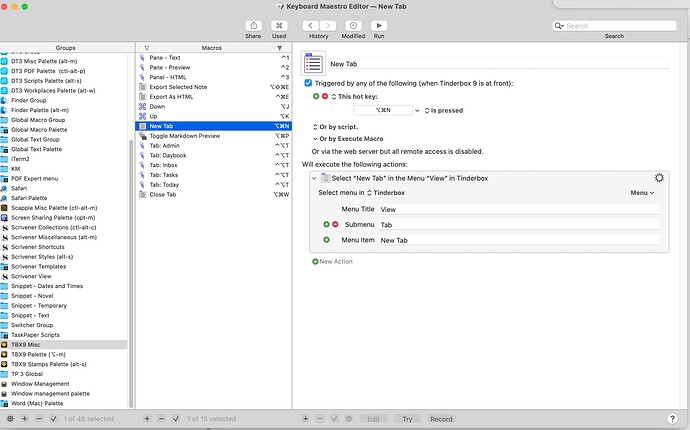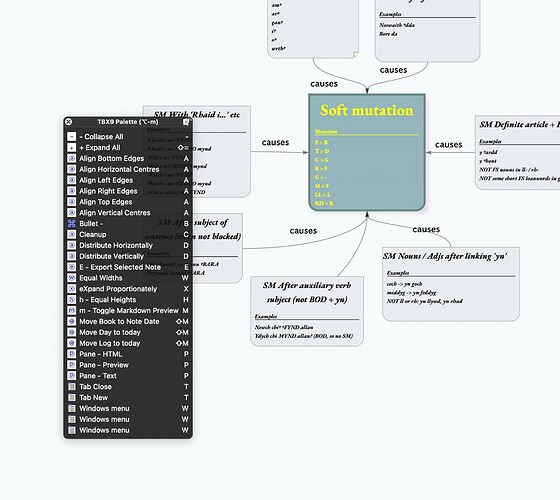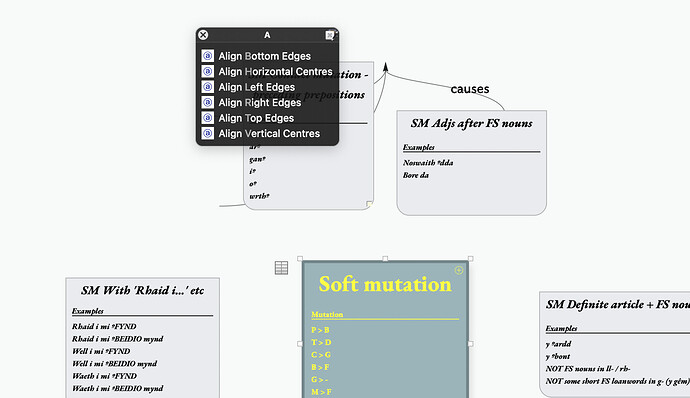Is it possible to select several notes at once and resize them all to the same size in one action?
I don’t know about using the handles to drag them to a specific size, but you can use quickstamp to set Width and Height for multiple notes.
edit: similarly, you could drag one to the size you want, and get its Width and Height and apply it to the other notes w/ quickstamp or some other action code / scripting mechanism.
No - though I get the idea, but that’s more of a drawing space mechanism, and Tinderbox isn’t a drawing app per se. It used to be the community valued the untidiness - or lack of over curation - of maps but it seems we’re giving into the the notion that neatness imparts insight (personally, I remain unconvinced).
$Height and $Width are intrinsic. But, don’t overlook View menu, Arrange -. Equal width or Equal Height. Note that such actions take their queue from the first selected item of the current selection.
Arrange is a perfect solution for this specific use case (dragging several articles from Devonthink to figure out relationships between them). I could see the stamp working well for future efforts, as well. Thank you, both, Mark and Pat!
I think, I am a bit autistic in this area ![]() … I prefer tidiness. Perhaps as a counterweight to some chaos in my head
… I prefer tidiness. Perhaps as a counterweight to some chaos in my head ![]()
I think much of our propensity towards tidiness is something learned at home and school. Control and consistency are aided by order and conformity. Thus, part of journey I’ve made in using Tinderbox is learning to eschew a learned liking for orderliness where it is only there without purpose.
That’s taught me that the clarity needed when communicating new or strange things to others, doesn’t necessarily help when the audience is just myself. At the early discovery stage, tidiness can simply obfuscate. When investigating the linkages and relationships in information and knowledge, order can confuse by implying relationships that do not in fact exist.
Wisely spoken… sounds reasonable
For me the issue is not having notes of the same size of uniformity, but being easily able to define a note’s viewable size. This would be analogous to fit column width in a spreadsheet. If either the width or height of a note is held constant, it would be nice if there was a keyboard command to resize the note to include all of the title.
Have you tried:
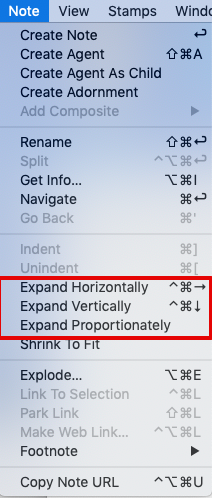
Thank you, Mark. Funny, I had seen the Expand Horizontally and Expand Vertically, but for some reason, I needed your red box to see Expand Proportionately. Expand proportionately works nicely. Using keyboard maestro, I can trigger the shortcut for any given note or a selection of notes.
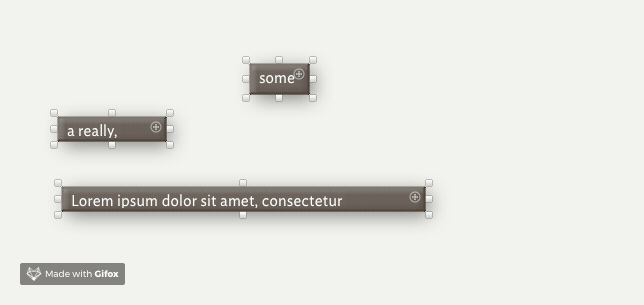
Neatness does seem an improbable source of insight, but perhaps a poor signal-to-noise ratio is also unlikely to spark much creativity ?
As pruning and integration continue, less graphic noise probably does reduce some friction in revealing and communicating whatever is emerging or being built.
(If the visual and spatial embedding didn’t make text more tractable and expressive, we might not reach for Tinderbox in the first place - a plain text outliner with tags and a scripting interface might well be more than enough)
Hmmm, not sure I agree here, Mark. Clearly, different people think differently and respond differently to visual stimulation. Part of the power of GTD, for example, is that you have a place for everything and everything in its place - you don’t have to carry it around in your (very messy) head, or have them in your visual field to distract you. You put stuff away and only deal with it in turn. “Mind like water” and all that.
Many of us software engineers tend to habitually make our code “beautiful” and elegant, such that we can up-level our thoughts to manage the complexity at a higher level. Good coding hygiene, e.g., OOP encapsulation, make it more understandable and keeps the messy details from obfuscating the structure you’ve so carefully given it.
And I’m only half-joking when I say that this sort of habitual, even compulsive tendencies towards form-following-function aesthetic beauty in an otherwise chaotic world may be at least partly genetic. I’m Dutch on my Mom’s side, and while I’ve never lived in Netherlands, I’ve read up on Dutch culture and recognized myself in many examples: if you hang clothes out to dry, don’t be surprised if you come back and find your clothes rearranged on the line in a more aesthetically pleasing way.
In any case, different people are comfortable with different levels of clutter. We just draw the line in different places - and likely draw it in different places under different circumstances. To paraphrase Einstein, IMHO things should be as tidy as possible, but no tidier.
My two cents only.
– jdm
No argument here, this is a broad church. My point is not that things should be ‘messy’, but rather that they may be and, in exploratory work, can help with serendipitous discovery. 
I’ve been thinking about what I’ll call “your philosophy of chaos” @mwra … I just realised something in two practices you propose that may be a contradiction. On the one hand, you seem to advocate chaos as being important for discovering things. (Society is obsessed with neatness, which you don’t fully believe in). Yet at the same time, you advocate listing things down step by step and clearly stating what the intended outcome is. The latter is an embodiment of ordering things, which is the opposite of chaos (at least temporal chaos, in terms of this comes first, then second, then third). It seems you advocate spatial chaos and temporal order. Chaos in one dimension, and order in another.  Isn’t that contradictory. Order is order. Chaos is chaos. Yes? No?
Isn’t that contradictory. Order is order. Chaos is chaos. Yes? No?
Hi Niram
How did you do that in Keyboard Maestro. Can you share the script? or explain how you did that.
Thanks in advance,
tom
Um, no! Exploration and documentation are very different things. They are not different dimensions but discrete tasks, the first normally proceeding the latter.
My comments re tidiness relate to avoiding premature formalisation, i.e. creating a structure that isn’t unambiguously there. Conversely, once a true structure has emerged, explaining it for others needs the lack of ambiguity I allude to elsewhere.
How did you do that in Keyboard Maestro. Can you share the script? or explain how you did that.
I’m not the OP, but the general method in Keyboard Maestro is to use the ‘Select or Show a Menu Item’ action.
The basic steps are:
- Create a new macro and name it
- Give the macro a keyboard hotkey
- Add a new action to the macro and choose ‘Select or Show a Menu Item’
- Click “Select Menu in” and choose “Tinderbox”, then click on the ‘Menu’ dropdown box on the right and navigate through to the item you actually want, which will be populate the various fields correctly.
That’s really all you have to do for simple macros. Here’s what one of mine looks like:
A more advanced (and really useful) technique is to create a new Macro Palette (with its own hotkey) and assign your various shortcut macros to it. Then all you have to do is use the hotkey to get your own bespoke menu of shortcut commands. (Tip: give the latter menus 1-letter hotkeys for convenience.)
Here’s my Tinderbox Misc macro palette. It means I can type alt-m h to get Equal Heights, for example.
You’ll see that several items have the same hotkey. E.g. alt-m a will trigger a new ‘conflict palette’ for the align commands: alt-m ab for Align Bottom Edges and so on. It’s just a way of cutting down on the number of hotkey letters you need.
But… don’t forget that there is a simpler way of using the keyboard for (some) menu commands within Tinderbox itself… Select the relevant notes, then press cmd-shift-u and you’ll get a ‘Spotlight’-like search box. Type in ‘equal height’ and one of the results will be Menu Equal Heights. This is often enough for those ‘not regular enough to warrant the faff of creating a new Keyboard Macro macro’ commands ![]()
HTH!
Aaah. Okay. So am I correct in saying that the first step is to leave things messy, and not impose an arbitrary order on them… but rather let the order emerge organically from within the mess, as opposed to imposing some pre-conceived arrangement that is extrinsic to the structure, but that conforms to what society calls “neatness”? Am I correct? If so… it makes sense. Hard to do though. Needs a sort of leap of faith and a bit of an “experimental” mindset. It needs being comfortable with swimming in dark waters for sometime.
Yes.
Quite so. It involves unlearning school-teaching to start by making outlines or lists. The latter is fine if that is truly what you are doing. But, when exploring a new topic in map view I find such false ordering unhelpful in the beginning.
In doing exploratory work, with messy maps, would you say a good next step would be clustering notes for spatial relationships and beginning to use agents are good next steps in finding these emerging themes?
Tom
